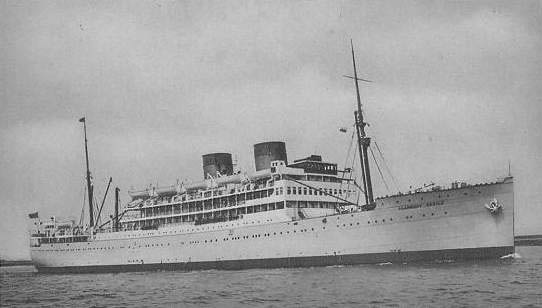Llangibby Castle
British Troop transport

| Name | Llangibby Castle | ||
| Type: | Troop transport | ||
| Tonnage | 11,951 tons | ||
| Completed | 1929 - Harland & Wolff Ltd, Govan, Glasgow | ||
| Owner | Union-Castle Mail SS Co Ltd, London | ||
| Homeport | London | ||
| Date of attack | 16 Jan 1942 | Nationality: | |
| Fate | Damaged by U-402 (Siegfried Freiherr von Forstner) | ||
| Position | 46° 04'N, 19° 06'W - Grid BE 5716 | ||
| Complement | 1356 (26 dead and 1330 survivors). | ||
| Convoy | WS-15 | ||
| Route | Gourock (12 Jan) - Freetown - Singapore | ||
| Cargo | 1164 troops and war material, including 500 tons of oil | ||
| History | Completed in November 1929 as motor passenger ship Llangibby Castle for Union-Castle Mail SS Co Ltd, London. In July 1940 requisitioned as troop transport after a voyage from Capetown to Falmouth and carried troops to South and East Africa. In the night on 21/22 December 1940, damaged during an air raid in Liverpool. On 9 November 1942 the Llangibby Castle was part of the KMF-convoy in Operation Torch, the landing in North Africa. She was hit by an 8in shell from a Vichy-French shore battery which killed one person. In 1943 the ship returned to the UK for repairs to her bow, which had been damaged at Gibraltar during the preparations for the Italian landings. At the same time, she was converted into a Landing Ship Infantry (LSI) equipped with 18 landing craft and able to carry 1590 troops. After making exercises at Loch Fyne, she spent the next six months ferrying troops in the Mediterranean. In 1944 HMS Llangibby Castle was allotted to Force J3 (Juno beach) for the Normandy landings, based at Southampton. She practiced the landings at Bracklesham Bay. On 6 June, she landed the first wave of 750 Canadian troops at Coirseilles, loosing ten of her landing craft, which swamped on the return trip with the loss of 12 lives. The second wave of 750 men had to be landed by the remaining landing craft, which had to make two trips. After nine hours, the ship returned to Southampton. She later landed troops at the Omaha and Utah beaches and also at Le Havre, in all she made over 70 crossings and carried over 100,000 troops. In 1945, the ship was converted back to a troop transport and carried out trooping duties in the Far East. Post-war: In January 1946 the Llangibby Castle made three voyages repatriating some 6000 West African troops from Burma and India including the total internees of a military prison. In January 1947 returned to the owner, after having sailed 300,256 miles and carrying 156,134 troops and resumed her service after a refit. On 29 Jun 1954, she sailed from Tilbury to Newport in Monmouthshire where she was broken up by J. Cashmore in July 1954. | ||
| Notes on event | At 11.15 hours on 16 January 1942 the Llangibby Castle (Master Ronald Frederick Bayer) in convoy WS-15 was torpedoed by U-402 north of the Azores. One torpedo hit the stern and blew away the after gun and the rudder, but the propellers remained intact. 26 of the troops aboard as passengers were killed by the explosion. The crew of 184 men and eight gunners managed to get the ship underway at 9 knots to Horta in the Azores, fighting off attacks by German Fw200 aircraft on the way, assisted by volunteers from the troops who manned anti-aircraft guns. The neutral Portugal allowed only 14 days for repairs and on 2 February, the ship had to left with the troops still on board and set course to Gibraltar, assisted by the rescue tug HMS Thames and escorted by the three destroyers HMS Westcott (D 47) (Cdr I.H. Bockett-Pugh, RN), HMS Exmoor (L 08) (LtCdr L.St.G. Rich, RN) and HMS Croome (L 62) (LtCdr J.D. Hayes, RN). On 3 February, the small convoy was followed by several U-boats, but none managed to hit the ship, while HMS Westcott sank U-581 (Pfeifer). On 8 February the troopship arrived at Gibraltar in tow of the tug and disembarked the troops. On 6 April, the Llangibby Castle left Gibraltar under escort after temporary repairs, but still without rudder, for the UK, arriving on 13 April. Altogether she sailed 3400 miles without a rudder and with a badly damaged stern, only using her engines for steering, a feat for which her master was awarded the CBE and the chief officer and chief engineer officer the OBE and Lloyds War Medal for bravery at sea. | ||
| On board | We have details of 41 people who were on board. | ||
If you can help us with any additional information on this vessel then please contact us.
